DSPL 結構定義
透過集合功能整理內容
你可以依據偏好儲存及分類內容。
本頁及其連結的子頁面記錄了 DSPL XML 架構。
此教材適用於有興趣瞭解的進階使用者
語言的低分資訊;對大多數使用者而言
在
開發人員指南應足以建立及編輯影片
DSPL 資料集
完整的 XML 架構可透過 XSD 格式下載
在
DSPL 程式碼網站。
元素:dspl
| 命名空間 |
http://schemas.google.com/dspl/2010 |
| 註解 |
DSPL 規格說明資料集,資料集是
識別物件資料集包含下列元素
元素:- 表格:定義
資料集 - 概念:
資料集 - 扇區:
資料集 - 主題:階層式標籤,用來整理
資料集 |
| 圖表 |
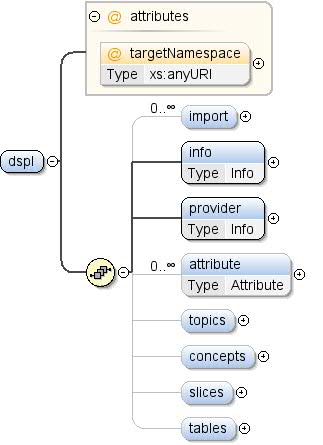 |
| 屬性 |
|
| 型號 |
import*、資訊、供應商、
屬性*、topics{0,1}、概念{0,1}、配量{0,1}、資料表{0,1} |
| 子項 |
屬性、概念、匯入、
info、供應商、切片、
資料表、主題 |
| 執行個體 |
<dspl targetNamespace="">
<import location="" namespace="">{0,unbounded}</import>
<info>{1,1}</info>
<provider>{1,1}</provider>
<attribute concept="" id="">{0,unbounded}</attribute>
<topics>{0,1}</topics>
<concepts>{0,1}</concepts>
<slices>{0,1}</slices>
<tables>{0,1}</tables>
</dspl>
|
| 屬性 |
| QName |
類型 |
固定 |
預設 |
使用 |
註解 |
| targetNamespace |
xs:anyURI |
|
|
選用 |
每個資料集可能會提供目標命名空間。目標
命名空間是專門用來識別資料集的 URI。如要
有關在 XML 中使用命名空間的詳細資訊,請參閱:
http://www.w3.org/TR/REC-xml-names/ 如果沒有 targetNamespace
系統就會在資料集
已匯入。 |
|
| 來源 |
<xs:element name="dspl">
<xs:annotation>
<xs:documentation>A DSPL specification describes a dataset. A dataset is
identified by its namespace. A dataset is comprised of the
following elements:
- Tables: Data for the concepts and slices defined in the
dataset
- Concepts: User-specified definitions and structures used in
the dataset
- Slices: Combinations of dimensions and metrics present in
the dataset
- Topics: Hierarchical labels used to organise the concepts of
the dataset</xs:documentation>
</xs:annotation>
<xs:complexType>
<xs:sequence>
<xs:element name="import" minOccurs="0" maxOccurs="unbounded">
<xs:annotation>
<xs:documentation>Import directive for external datasets -- modeled after
the XML Schema import directive. In order to use
elements defined in an external dataset, the external
dataset must be referenced using an import directive.</xs:documentation>
</xs:annotation>
<xs:complexType>
<xs:attribute name="namespace" use="required">
<xs:annotation>
<xs:documentation>The namespace of the imported dataset, specified as
a URI. A prefix must be associated with this
namespace before its contents can be referenced. See
[XML Namespaces] for more information about the use
of namespaces and prefixes in XML.</xs:documentation>
</xs:annotation>
</xs:attribute>
<xs:attribute name="location" use="optional">
<xs:annotation>
<xs:documentation>An optional location where the definition of the
imported dataset can be found, specified as a
URL. If the location is omitted, the system
processing this DSPL dataset must already know the
imported dataset.
Implementation note: The Google dataset importer
ignores the location attribute. Any imported dataset
must be known by the Google importer beforehand.</xs:documentation>
</xs:annotation>
</xs:attribute>
</xs:complexType>
</xs:element>
<xs:element name="info" type="Info" minOccurs="1">
<xs:annotation>
<xs:documentation>General information about the dataset.</xs:documentation>
</xs:annotation>
</xs:element>
<xs:element name="provider" type="Info">
<xs:annotation>
<xs:documentation>General information about the dataset provider.</xs:documentation>
</xs:annotation>
</xs:element>
<xs:element name="attribute" type="Attribute" minOccurs="0" maxOccurs="unbounded">
<xs:annotation>
<xs:documentation>Attribute associated with the dataset.</xs:documentation>
</xs:annotation>
</xs:element>
<xs:element name="topics" minOccurs="0">
<xs:annotation>
<xs:documentation>A hierarchy of topics used to organize the contents of
the dataset. The order in which topics are given is
meaningful and should be respected by visualizations
that displays these topics.</xs:documentation>
</xs:annotation>
<xs:complexType>
<xs:sequence>
<xs:element name="topic" type="Topic" maxOccurs="unbounded"/>
</xs:sequence>
</xs:complexType>
</xs:element>
<xs:element name="concepts" minOccurs="0">
<xs:annotation>
<xs:documentation>A list of concepts defined in this dataset.</xs:documentation>
</xs:annotation>
<xs:complexType>
<xs:sequence>
<xs:element name="concept" type="Concept" maxOccurs="unbounded"/>
</xs:sequence>
</xs:complexType>
</xs:element>
<xs:element name="slices" minOccurs="0">
<xs:annotation>
<xs:documentation>A list of slices defined in this dataset.</xs:documentation>
</xs:annotation>
<xs:complexType>
<xs:sequence>
<xs:element name="slice" type="Slice" maxOccurs="unbounded"/>
</xs:sequence>
</xs:complexType>
</xs:element>
<xs:element name="tables" minOccurs="0">
<xs:annotation>
<xs:documentation>A list of tables defined in this dataset.</xs:documentation>
</xs:annotation>
<xs:complexType>
<xs:sequence>
<xs:element name="table" type="Table" maxOccurs="unbounded"/>
</xs:sequence>
</xs:complexType>
</xs:element>
</xs:sequence>
<xs:attribute name="targetNamespace" type="xs:anyURI" use="optional">
<xs:annotation>
<xs:documentation>Each dataset may provide a target namespace. The
target namespace is a URI that uniquely identifies the
dataset. For more information about the use of namespaces in XML,
see:
http://www.w3.org/TR/REC-xml-names/
If no targetNamespace is provided, then a namespace will be
generated when the dataset is imported.</xs:documentation>
</xs:annotation>
</xs:attribute>
</xs:complexType>
</xs:element>
|
元素:dspl / import
| 命名空間 |
http://schemas.google.com/dspl/2010 |
| 註解 |
外部資料集的匯入指令 -- 以 XML 為基礎建立模型
結構定義匯入指令。如要使用在外部定義的
資料集,就必須透過匯入功能來參照外部資料集
指令。 |
| 圖表 |
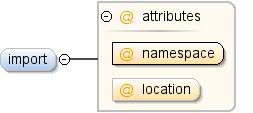 |
| 屬性 |
| content: |
複雜 |
| 分鐘數: |
0 |
| maxOccurs: |
無界限 |
|
| 屬性 |
| QName |
類型 |
固定 |
預設 |
使用 |
註解 |
| 位置資訊 |
|
|
|
選用 |
選用位置,定義已匯入的
指定資料集,並將其指定為網址。如果位置:
省略後,處理這個 DSPL 資料集的系統必須知道
匯入資料集導入註意事項:Google 資料集
匯入工具會忽略位置屬性。任何匯入的資料集都必須
Google 匯入工具預先得知資訊 |
| 命名空間 |
|
|
|
必填 |
匯入資料集的命名空間,指定為
URI。前置字串必須與這個命名空間建立關聯,才能
資源。詳情請參閱 [XML 命名空間]
瞭解在容器中使用的命名空間和前置字元
XML。 |
|
| 來源 |
<xs:element name="import" minOccurs="0" maxOccurs="unbounded">
<xs:annotation>
<xs:documentation>Import directive for external datasets -- modeled after
the XML Schema import directive. In order to use
elements defined in an external dataset, the external
dataset must be referenced using an import directive.</xs:documentation>
</xs:annotation>
<xs:complexType>
<xs:attribute name="namespace" use="required">
<xs:annotation>
<xs:documentation>The namespace of the imported dataset, specified as
a URI. A prefix must be associated with this
namespace before its contents can be referenced. See
[XML Namespaces] for more information about the use
of namespaces and prefixes in XML.</xs:documentation>
</xs:annotation>
</xs:attribute>
<xs:attribute name="location" use="optional">
<xs:annotation>
<xs:documentation>An optional location where the definition of the
imported dataset can be found, specified as a
URL. If the location is omitted, the system
processing this DSPL dataset must already know the
imported dataset.
Implementation note: The Google dataset importer
ignores the location attribute. Any imported dataset
must be known by the Google importer beforehand.</xs:documentation>
</xs:annotation>
</xs:attribute>
</xs:complexType>
</xs:element>
|
元素:dspl / info
| 命名空間 |
http://schemas.google.com/dspl/2010 |
| 註解 |
資料集的一般資訊。 |
| 圖表 |
 |
| 類型 |
資訊 |
| 屬性 |
|
| 型號 |
name、description{0,1}、url{0,1} |
| 子項 |
description、name、url |
| 執行個體 |
<info>
<name>{1,1}</name>
<description>{0,1}</description>
<url>{0,1}</url>
</info>
|
| 來源 |
<xs:element name="info" type="Info" minOccurs="1">
<xs:annotation>
<xs:documentation>General information about the dataset.</xs:documentation>
</xs:annotation>
</xs:element>
|
元素:dspl / provider
| 命名空間 |
http://schemas.google.com/dspl/2010 |
| 註解 |
資料集提供者的一般資訊。 |
| 圖表 |
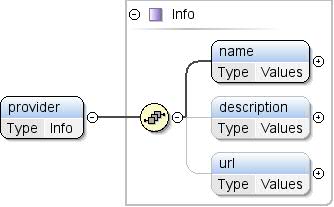 |
| 類型 |
資訊 |
| 屬性 |
|
| 型號 |
name、description{0,1}、url{0,1} |
| 子項 |
description、name、url |
| 執行個體 |
<provider>
<name>{1,1}</name>
<description>{0,1}</description>
<url>{0,1}</url>
</provider>
|
| 來源 |
<xs:element name="provider" type="Info">
<xs:annotation>
<xs:documentation>General information about the dataset provider.</xs:documentation>
</xs:annotation>
</xs:element>
|
| 命名空間 |
http://schemas.google.com/dspl/2010 |
| 註解 |
與資料集相關聯的屬性, |
| 圖表 |
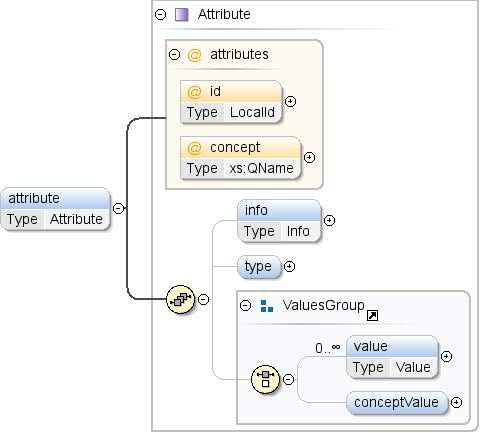 |
| 類型 |
屬性 |
| 屬性 |
| content: |
複雜 |
| 分鐘數: |
0 |
| maxOccurs: |
無界限 |
|
| 型號 |
info{0,1},type{0,1}, (value*
|conceptValue{0,1}) |
| 子項 |
conceptValue、info、type、
值 |
| 執行個體 |
<attribute concept="" id="">
<info>{0,1}</info>
<type format="" ref="">{0,1}</type>
</attribute>
|
| 屬性 |
| QName |
類型 |
固定 |
預設 |
使用 |
註解 |
| 概念 |
xs:QName |
|
|
選用 |
所對應概念的概念參照
屬性。如果屬性指定了類型,請將類型
必須符合所參照概念的類型。對於
外部概念必須採用下列格式
「prefix:other_concept_id」,其中「prefix」為
外部資料集命名空間使用的前置字串 (請參閱 XML
命名空間)。 |
| id |
LocalId |
|
|
選用 |
概念屬性的 ID,此 ID 必須是
屬於特定類別 (所有屬性和屬性) 的不重複值
如果已指定概念屬性,則可省略 ID。在這個例子中
系統會建立隱含的 ID,並將值做為
所學概念例如 <attribute
concept="unit:currency"/>相當於
<attribute id="currency"
concept="unit:currency"/> |
|
| 來源 |
<xs:element name="attribute" type="Attribute" minOccurs="0" maxOccurs="unbounded">
<xs:annotation>
<xs:documentation>Attribute associated with the dataset.</xs:documentation>
</xs:annotation>
</xs:element>
|
元素:dspl / topic
| 命名空間 |
http://schemas.google.com/dspl/2010 |
| 註解 |
主題階層,可用來組織
主題的指定順序有意義且必須
並以圖表呈現這些主題。 |
| 圖表 |
 |
| 屬性 |
|
| 型號 |
topic+ |
| 子項 |
主題 |
| 執行個體 |
<topics>
<topic id="" parentTopic="">{1,unbounded}</topic>
</topics>
|
| 來源 |
<xs:element name="topics" minOccurs="0">
<xs:annotation>
<xs:documentation>A hierarchy of topics used to organize the contents of
the dataset. The order in which topics are given is
meaningful and should be respected by visualizations
that displays these topics.</xs:documentation>
</xs:annotation>
<xs:complexType>
<xs:sequence>
<xs:element name="topic" type="Topic" maxOccurs="unbounded"/>
</xs:sequence>
</xs:complexType>
</xs:element>
|
| 命名空間 |
http://schemas.google.com/dspl/2010 |
| 圖表 |
 |
| 類型 |
主題 |
| 屬性 |
| content: |
複雜 |
| maxOccurs: |
無界限 |
|
| 型號 |
資訊、主題* |
| 子項 |
info、topic |
| 執行個體 |
<topic id="" parentTopic="">
<info>{1,1}</info>
<topic id="" parentTopic="">{0,unbounded}</topic>
</topic>
|
| 屬性 |
| QName |
類型 |
固定 |
預設 |
使用 |
註解 |
| id |
ID |
|
|
必填 |
資料集。 |
| parentTopic |
xs:QName |
|
|
選用 |
此主題的父項主題 ID (如果有的話)。
在內嵌主題中,無法指定父項主題
其他主題。 |
|
| 來源 |
<xs:element name="topic" type="Topic" maxOccurs="unbounded"/>
|
| 命名空間 |
http://schemas.google.com/dspl/2010 |
| 註解 |
這個資料集中定義的概念清單。 |
| 圖表 |
 |
| 屬性 |
|
| 型號 |
概念 + |
| 子項 |
概念 |
| 執行個體 |
<concepts>
<concept extends="" id="">{1,unbounded}</concept>
</concepts>
|
| 來源 |
<xs:element name="concepts" minOccurs="0">
<xs:annotation>
<xs:documentation>A list of concepts defined in this dataset.</xs:documentation>
</xs:annotation>
<xs:complexType>
<xs:sequence>
<xs:element name="concept" type="Concept" maxOccurs="unbounded"/>
</xs:sequence>
</xs:complexType>
</xs:element>
|
| 命名空間 |
http://schemas.google.com/dspl/2010 |
| 圖表 |
 |
| 類型 |
概念 |
| 屬性 |
| content: |
複雜 |
| maxOccurs: |
無界限 |
|
| 型號 |
info、topic*、type{0,1}、
attribute*、property*、defaultValue{0,1}、table{0,1} |
| 子項 |
attribute、defaultValue、info、
屬性、資料表、主題、
類型 |
| 執行個體 |
<concept extends="" id="">
<info>{1,1}</info>
<topic ref="">{0,unbounded}</topic>
<type ref="">{0,1}</type>
<attribute concept="" id="">{0,unbounded}</attribute>
<property concept="" id="" isMapping="false" isParent="false">{0,unbounded}</property>
<defaultValue>{0,1}</defaultValue>
<table ref="">{0,1}</table>
</concept>
|
| 屬性 |
| QName |
類型 |
固定 |
預設 |
使用 |
註解 |
| 延伸 |
xs:QName |
|
|
選用 |
該概念的專屬 ID
。參照的概念可在同一個資料集中定義
也就是在其他資料集中對外部 IP 位址的參照
概念必須採用「prefix:other_concept_id」格式、
其中「prefix」是 Pod 中
外部資料集 (請參閱 XML 命名空間)。 |
| id |
ID |
|
|
必填 |
概念的專屬 ID,必須是
資料集內的全域不重複值 |
|
| 來源 |
<xs:element name="concept" type="Concept" maxOccurs="unbounded"/>
|
元素:dspl / slices
| 命名空間 |
http://schemas.google.com/dspl/2010 |
| 註解 |
這個資料集中定義的配量清單。 |
| 圖表 |
 |
| 屬性 |
|
| 型號 |
Slice + |
| 子項 |
slice |
| 執行個體 |
<slices>
<slice id="">{1,unbounded}</slice>
</slices>
|
| 來源 |
<xs:element name="slices" minOccurs="0">
<xs:annotation>
<xs:documentation>A list of slices defined in this dataset.</xs:documentation>
</xs:annotation>
<xs:complexType>
<xs:sequence>
<xs:element name="slice" type="Slice" maxOccurs="unbounded"/>
</xs:sequence>
</xs:complexType>
</xs:element>
|
| 命名空間 |
http://schemas.google.com/dspl/2010 |
| 圖表 |
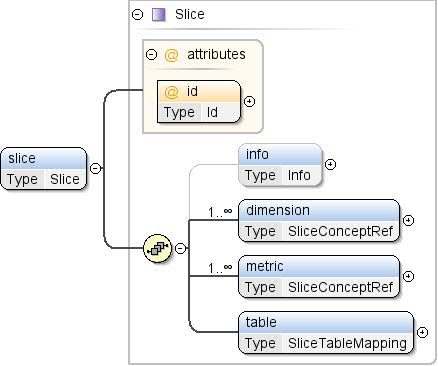 |
| 類型 |
片段 |
| 屬性 |
| content: |
複雜 |
| maxOccurs: |
無界限 |
|
| 型號 |
info{0,1}、dimension+、metric+
, 表格 |
| 子項 |
維度、資訊、指標、
表格 |
| 執行個體 |
<slice id="">
<info>{0,1}</info>
<dimension concept="">{1,unbounded}</dimension>
<metric concept="">{1,unbounded}</metric>
<table ref="">{1,1}</table>
</slice>
|
| 屬性 |
| QName |
類型 |
固定 |
預設 |
使用 |
註解 |
| id |
ID |
|
|
必填 |
該片段的專屬 ID。 |
|
| 來源 |
<xs:element name="slice" type="Slice" maxOccurs="unbounded"/>
|
元素:dspl / table
| 命名空間 |
http://schemas.google.com/dspl/2010 |
| 註解 |
這個資料集中定義的資料表清單。 |
| 圖表 |
 |
| 屬性 |
|
| 型號 |
table+ |
| 子項 |
表格 |
| 執行個體 |
<tables>
<table id="">{1,unbounded}</table>
</tables>
|
| 來源 |
<xs:element name="tables" minOccurs="0">
<xs:annotation>
<xs:documentation>A list of tables defined in this dataset.</xs:documentation>
</xs:annotation>
<xs:complexType>
<xs:sequence>
<xs:element name="table" type="Table" maxOccurs="unbounded"/>
</xs:sequence>
</xs:complexType>
</xs:element>
|
| 命名空間 |
http://schemas.google.com/dspl/2010 |
| 圖表 |
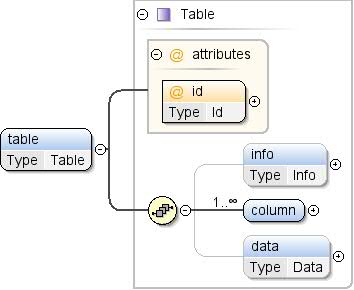 |
| 類型 |
表格 |
| 屬性 |
| content: |
複雜 |
| maxOccurs: |
無界限 |
|
| 型號 |
info{0,1}、欄+、資料{0,1} |
| 子項 |
資料欄、資料、資訊 |
| 執行個體 |
<table id="">
<info>{0,1}</info>
<column format="" id="" type="">{1,unbounded}</column>
<data>{0,1}</data>
</table>
|
| 屬性 |
| QName |
類型 |
固定 |
預設 |
使用 |
註解 |
| id |
ID |
|
|
必填 |
資料集。 |
|
| 來源 |
<xs:element name="table" type="Table" maxOccurs="unbounded"/>
|
| 命名空間 |
沒有命名空間 |
| 註解 |
匯入資料集的命名空間,以 URI 的形式指定。A 罩杯
前置字串必須與這個命名空間相關聯,才能
參照。如要進一步瞭解
XML 中的命名空間和前置字元。 |
| 屬性 |
|
| 使用這項素材資源的廣告 |
|
| 來源 |
<xs:attribute name="namespace" use="required">
<xs:annotation>
<xs:documentation>The namespace of the imported dataset, specified as
a URI. A prefix must be associated with this
namespace before its contents can be referenced. See
[XML Namespaces] for more information about the use
of namespaces and prefixes in XML.</xs:documentation>
</xs:annotation>
</xs:attribute>
|
| 命名空間 |
沒有命名空間 |
| 註解 |
選用位置,定義已匯入的
指定資料集,並將其指定為網址。省略位置時,
系統在處理這個 DSPL 資料集時必須知道
導入註意事項:Google 資料集匯入工具會忽略
location 屬性任何匯入的資料集都必須由 Google
匯入程式。 |
| 屬性 |
|
| 使用這項素材資源的廣告 |
|
| 來源 |
<xs:attribute name="location" use="optional">
<xs:annotation>
<xs:documentation>An optional location where the definition of the
imported dataset can be found, specified as a
URL. If the location is omitted, the system
processing this DSPL dataset must already know the
imported dataset.
Implementation note: The Google dataset importer
ignores the location attribute. Any imported dataset
must be known by the Google importer beforehand.</xs:documentation>
</xs:annotation>
</xs:attribute>
|
屬性:dspl / @targetNamespace
| 命名空間 |
沒有命名空間 |
| 註解 |
每個資料集可能會提供目標命名空間。目標
命名空間是專門用來識別資料集的 URI。如要
有關在 XML 中使用命名空間的詳細資訊,請參閱:
http://www.w3.org/TR/REC-xml-names/ 如未提供 targetNamespace,
系統會在資料集
已匯入。 |
| 類型 |
xs:anyURI |
| 屬性 |
|
| 使用這項素材資源的廣告 |
|
| 來源 |
<xs:attribute name="targetNamespace" type="xs:anyURI" use="optional">
<xs:annotation>
<xs:documentation>Each dataset may provide a target namespace. The
target namespace is a URI that uniquely identifies the
dataset. For more information about the use of namespaces in XML,
see:
http://www.w3.org/TR/REC-xml-names/
If no targetNamespace is provided, then a namespace will be
generated when the dataset is imported.</xs:documentation>
</xs:annotation>
</xs:attribute>
|
使用
oXygen XML 編輯器。
除非另有註明,否則本頁面中的內容是採用創用 CC 姓名標示 4.0 授權,程式碼範例則為阿帕契 2.0 授權。詳情請參閱《Google Developers 網站政策》。Java 是 Oracle 和/或其關聯企業的註冊商標。
上次更新時間:2025-07-25 (世界標準時間)。
[[["容易理解","easyToUnderstand","thumb-up"],["確實解決了我的問題","solvedMyProblem","thumb-up"],["其他","otherUp","thumb-up"]],[["缺少我需要的資訊","missingTheInformationINeed","thumb-down"],["過於複雜/步驟過多","tooComplicatedTooManySteps","thumb-down"],["過時","outOfDate","thumb-down"],["翻譯問題","translationIssue","thumb-down"],["示例/程式碼問題","samplesCodeIssue","thumb-down"],["其他","otherDown","thumb-down"]],["上次更新時間:2025-07-25 (世界標準時間)。"],[],["The DSPL XML schema defines a dataset's structure using key components: `tables`, `concepts`, `slices`, and `topics`. The root `dspl` element encapsulates the dataset, utilizing `import` to reference externals, `info` and `provider` for metadata, `attribute` for dataset attributes, and `topics` to hierarchically organize the concepts. `concepts`, `slices`, `tables` are for concept definition, slice definition, and data table, respectively. Each element like `import`, `info`, `provider`, `attribute`, `topic`, `concept`, `slice`, `table` uses specific attributes and child elements for configuration. Each element has a specific cardinality that is defined in the document.\n"]]













